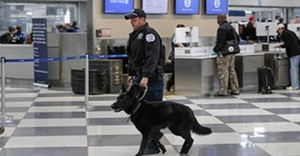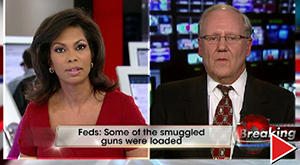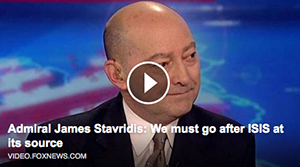

Specialized Consulting in Security
Management Issues Worldwide
- MENU
- HOME
- ABOUT
- CONSULTING SERVICES
- • Installing the right business management team and strategy
- • Creating impactful sales and marketing models
- • Managing the risks and rewards of new product development
- • Understanding the most appropriate technology applications
- • Ensuring safety at borders and checkpoints
- • Passing TSA EDS certification tests / EDS algorithm development
- TEAM
- FLAGS
- CONTACT
Yankee Foxtrot White Papers
Collection of Articles
FACILITATION & SECURITY –
Could infrared video imaging be the solution to concerns over backscatter technology?
Peter Harris, Business Week –
The Next Wave of Airline Security Systems
Weber Shandwick –
Policies - Security - Perspective
-- Peter Harris
Sr. Strategic Officer of ISCON
AOL Nation –
Obama Budget Adds 1,000 Airport Body Screeners
Joel Siegfried, Examiner.com –
New airport scanner shows weapons, not nudity
YF News

Peter Harris interviewed in AP article on Brussels attack:

Tom Blank interviewed on Fox News Insider on Brussels attack:
"Former TSA Deputy Director Tom Blank said this is the result of a security gap being exposed…"

James Stavridis interviewed on Fox News Insider on Brussels attack:
Admiral James Stavridis: We must go after ISIS at its source…
White Papers
Press Release, February 1 – 2011
Yankee Foxtrot gains bench strength with addition of senior consultant
Peter Harris comments, “I am delighted to add Nicolas Acker to the Yankee Foxtrot team. Nicolas is an expert on political and security issues throughout Europe and has proven analytical skills.”
Press Release, Nov 19 – 2010
Frontal Pat Downs - It’s Getting Personal
![]() Download the White Paper Version
Download the White Paper Version
The TSA is facing a national/political crisis with the introduction of more comprehensive pat downs with the “front” of the hand. Travelers are furious, the Agency is defensive and everybody is talking about it.
How did we get here and how are we going to get out of this mess? First of all, though they cannot say it publicly, it seems obvious that the TSA is reacting to intelligence reports that the threat against commercial aircraft has ratcheted up once again. With an increased threat and the present deployment of body scanning systems incomplete, the checkpoints are vulnerable. And they are vulnerable at a time when many people will be traveling- the end of year holiday season. However, this is not the time to call in the cavalry and initiate “enhanced pat downs”.
While anyone can understand the invasive nature of “front” of the hand pat downs, it is important to take a closer look at why passengers are upset. Wasn’t it just two weeks ago that public surveys were giving the installed whole body imaging equipment 80% approval ratings – so what happened?
From this close observer, the transition to the more aggressive search was the last straw. Passengers had put up with the body scanners for the sake of security and getting to their destination in one piece. After all, in their minds, it hadn’t even been a year since that Nigerian suicide bomber tried to blow himself up over Detroit. Sure there were privacy and health issues to worry about, but when suddenly the new mandate for “enhanced” pat downs was declared those underlying concerns and anxieties quickly bubbled up into outrage. It wasn’t enough that the government was stripping you of your outer clothing – now you had to be groped as well? The torture of the American traveler had simply gone too far.
The passengers’ anger has been well chronicled over the last few days - their rights have been violated; their religion does not allow them to be touched; ladies feel that they are being fondled; sexual abuse victims feel re-threatened and we all know the viral quote - “if you touch my junk, I’ll have you arrested”.
And so how did the TSA address these legitimate complaints? They called a Press Conference and their Administrator not only defended the new policy, but also admitted incredulously that the new pat downs were both invasive and uncomfortable.
Recommendation #1
The TSA should hire a national spokesman immediately– the Agency is just not equipped to deal with a national /political crisis - there could be a very good reason why they are taking extra precautions with passengers during this holiday season, but they should consider briefing Congress in a secure setting so that they can get Congress on their side!
Recommendation #2
The TSA should consider alternative ways to scan passengers. Technology exists today that does not have the attendant privacy and radiation issues that the presently deployed equipment have. This testing should start now.
Recommendation #3
The TSA should develop a risk-based approach to scanning passengers. When you have the Agency patting down every single person with a knee or hip implant you know we have a problem. When you see TSO’s furiously patting down grandmothers on walkers you know we have a problem. When we treat everybody as a potential terrorist you know we have a security system that is fundamentally broken.
The number of passengers who fly on our commercial airliners doubles every ten years. And with the baby boomers retiring, the problem is not going to go away. It seems that sheer common sense dictates that we move toward the proven Israeli model of trying to figure out exactly who is flying on our airplanes.
Fortunately it is not difficult. Call it profiling, credentialing or just advanced passenger processing, most of the information needed can be gained through the reservations process. Other information on future passengers can be gleaned quickly from credit cards, biometric data and even registered traveler programs. Once that information is collected, the level of security that passengers will go through at an airport can be based on his/her biographical data.
Recommendation #4
Once a risk-based approach to scanning passengers is implemented, I would also recommend strongly that a major component of the new security protocol be random scannings. In this way, those on the side who want to do us harm by devising ways around our security protocols will never really know when and where a more comprehensive scanning could take place – and that is the best deterrent of them all – the randomness of a mixture of well-conceived security procedures.
 Nicolas Acker
Nicolas Acker